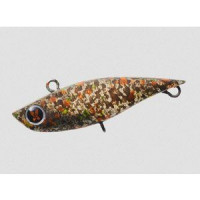While many dart lures have been released by various companies in recent years, the performance I sought for this step dart is the sinking speed and dart performance that cannot be seen by fish, and bottom stability. For example, in a situation where there is strong artificial pressure such as a tournament, the final part-time job is often limited to the "offshore surface" or "front bottom" where the pressure is relatively low. The surface layer off the coast is the only place for spoons to fly a long distance, but on the contrary, the fish are closer to the angler in the foreground, so a reaction element is strongly required. In such a situation, a dirt lure will be introduced, but no matter how high the dirt performance is, if the fall speed is slow, it will be cut off by the fish, and conversely if the fall speed is increased, the buoyancy will be impaired and the dirt will be lost. Performance and bottom stability performance deteriorate. The emphasis was on balancing these conflicting elements well.
The dirt width is also an important point. Generally, the wider the dirt width, the stronger the ability to attract fish, but especially in rainbow trout, it is not possible to keep up with the lure and misbites occur frequently. As the name suggests, step darts are good at "regular and small darts that take steps", and while realizing actions to reduce miss bites, they also have the power to forcibly raise the activity of neutral fish. It is a final weapon that is effective when you really want to squeeze fish.
- US +1 640 333 8340
130-0001, 3-2-7, Azumabashi, Sumidaku, Tokyo, Japan
10:00—18:00Mon—Fri
United States
Is your country United States?
- 配件和工具
- 书籍和视频
- 箱子和包
- 钓鱼线
- 钩、坠子和其他
- 液体和粉末
- ABU GARCIA
- ACCEL
- ANGLE
- ANGLERS REPUBLIC
- ARON ALPHA
- AWABI HONPO
- BAIT BREATH
- BELCADIA
- BERKLEY
- BONANZA
- BOND
- BOZLES
- BUG PROTECTOR
- CAPS
- CARAVAN
- CARMATE
- CEMEDINE
- COLUMBUS
- DAIWA
- DISM
- DRESS
- ECOGEAR
- ENGINE
- EVERGREEN
- FIELD HUNTER
- FINESSE
- FISH ARROW
- FISHMAN
- FIVECORE
- FLUX
- GAIANOTES
- GEECRACK
- GIMIK
- GLITCH
- GOLDEN MEAN
- HANSHIN
- HMKL
- IKARI
- INX.LABEL
- IOS FACTORY
- IVYLINE
- JACKALL
- JUMPRIZE
- KAHARA
- KOHINATA
- KONISHI
- LEVITATION ENGINEERING
- LIBERTA
- LITTLE PRESENTS
- LIVRE
- LUMICA
- M.T.C.W.
- MADNESS
- MARUKYU
- MARUNISHI
- MARUSHIN
- MC SQUARED
- MEIHO
- MONT-BELL
- MORRIS
- MR. HOBBY
- MUKAI
- NAGANO CORPORATION
- NAGASHIMA
- NAKAZIMA
- NATURE BOYS
- NGS
- NIKWAX
- NITTOU
- NO BRAND
- NORIES
- NOVEL ARMS
- OFFICE EUCALYPTUS
- OWNER
- PROSTAFF
- REINS
- S-PACK
- SAKURA
- SANKO
- SEAFLOOR CONTROL
- SENSHOU
- SEVEN-CHEMICAL
- SHIMANO
- SLP WORKS
- SMART VISION
- SMITH
- SOFT99
- SOME Q
- SOTO
- SPECT MORALIA
- STRUT
- SUNLINE
- TAKA
- TANE.MAKI
- TB
- TENRYU
- THREE BOND
- TIEMCO
- TOHO
- TSUCHIYA YAC
- TSURI CARE
- TSURI MUSHA
- TSURI VISION
- TSURIGU
- TSURIYOSHI HORMONE
- UMEEBE
- VAGABOND
- VALLEY HILL
- VARIVAS
- XESTA
- YAMATOYO
- YARIE
- YT
- YZ CRAFT
- ZACT CRAFT
- ZAPPU
- ZPI
- 诱饵
- 渔轮
- 渔竿
- 衣服
Presso Step Dart















